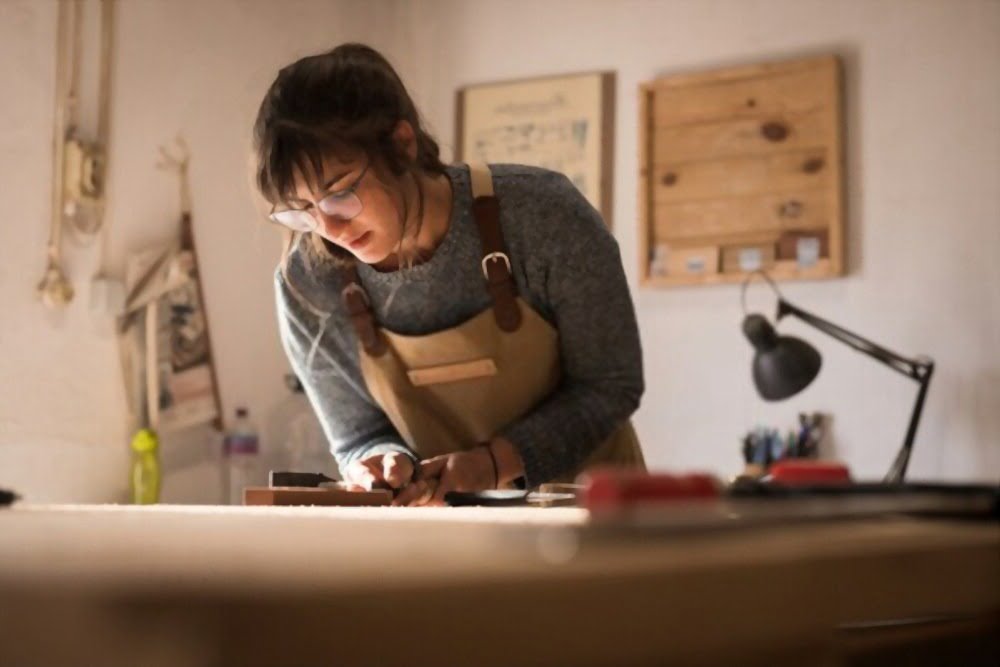Woodworking has long been regarded as a cherished craft that allows individuals to tap into their creativity while also providing a sense of fulfillment. In recent years, woodworking has experienced a surge in popularity as more and more people discover its relaxing and therapeutic qualities. The beauty of woodworking lies in the fact that it offers endless possibilities, allowing you to create unique and personalized projects that showcase your skills and passion for craftsmanship.
One of the most satisfying aspects of woodworking is witnessing the transformation of raw materials into beautiful and functional items. Whether you are crafting a custom bookshelf, building a picture frame, or designing a cutting board, each project presents an opportunity to bring your vision to life using wood as your medium. Working with wood not only hones your technical skills but also ignites the imagination, giving you the freedom to experiment with different designs and techniques.
Moreover, woodworking has the power to provide a much-needed break from the demands of everyday life. In this fast-paced world where digital screens dominate our attention, crafting something tangible with our hands allows us to reconnect with nature and engage in mindful activities. Woodworking can be an escape from stressors, allowing us to immerse ourselves in the process of creation and experience a sense of accomplishment with every finished piece.
In this article, we will explore everything you need to know about woodworking projects – from essential tools for beginners to selecting the right type of wood for your projects. We will provide step-by-step guides on how to plan and complete various woodworking projects while offering troubleshooting tips for common challenges along the way. Additionally, we will showcase beginner-friendly project ideas that will inspire you to embark on your own creative journey in woodworking.
Whether you’re a novice looking to start a new hobby or someone with some experience seeking inspiration and guidance, this article is here to help you begin or expand upon your woodworking journey. So grab your tools, roll up your sleeves and prepare yourself for an enriching adventure filled with sawdust and the smell of fresh wood – because woodworking is not just a hobby, it’s a passion that can bring immense joy and satisfaction to your life.
Essential Woodworking Tools for Beginners
Woodworking is a versatile and rewarding hobby that allows individuals to unleash their creativity and create beautiful, functional pieces from scratch. Whether you’re a beginner just starting out or someone looking to expand their woodworking tool collection, having the essential tools is crucial to the success of your projects. In this section, we will discuss the necessary woodworking tools for beginners, explain their purpose, and provide recommendations and tips for budget-friendly options.
Measuring and Marking Tools
- Tape Measure: Used for precise measurements when determining the length, width, or depth of wood.
- Combination Square: Helps in marking 90-degree angles accurately and checking for flatness or straightness.
- Marking Gauge: Enables you to mark parallel lines or designate specific dimensions on your wood.
Cutting Tools
- Handsaw: A versatile tool used for making straight cuts in small to medium-sized pieces of wood.
- Circular Saw: Perfect for cutting large sheets of plywood or lumber quickly and accurately.
- Coping Saw: Ideal for curved cuts or intricate designs where precise control is required.
Shaping Tools
- Chisels: Used to remove unwanted wood material or carve intricate details.
- Wood Files: Necessary for smoothing rough edges, shaping curves, and enlarging holes.
- Rasp: Ideal for rapid removal of wood with aggressive teeth while leaving a relatively smooth surface.
Joinery Tools
- Hammer: Essential for driving nails into the wood during assembly.
- Screwdriver Set: Enables you to tighten screws and ensure the stability of your project.
- Clamps: Crucial for holding pieces together firmly while glue dries or during assembly.
When purchasing woodworking tools as a beginner, it’s important to keep your budget in mind. Consider investing in quality tools that will last but also look out for affordable options. Garage sales, online marketplaces, and second-hand stores can be great places to find used tools at a fraction of the cost. Additionally, consider borrowing or renting tools that you may not use frequently.
By acquiring these essential woodworking tools for beginners, you will have a solid foundation to start your woodworking journey. As you gain experience and tackle more projects, you can gradually add to your collection based on the specific needs of each project. Remember to always use your tools safely and responsibly by following all manufacturer instructions and wearing the appropriate safety gear. With time and practice, you’ll soon find yourself confidently creating stunning woodworking projects.
Selecting the Right Type of Wood for Your Project
Wood selection is a crucial aspect when it comes to woodworking projects. Choosing the right type of wood for your project is essential in ensuring the durability, aesthetic appeal, and overall success of your creation. This section will provide guidance on how to select the appropriate wood for specific projects by explaining the importance of choosing the right wood and discussing the different types of wood available and their characteristics.
When selecting wood for your project, it is important to consider factors such as durability, appearance, and workability. Different types of wood have different properties that make them suitable for certain projects. For example, hardwoods like oak or cherry are known for their durability and strength, making them ideal for furniture-making projects. Softwoods like pine or cedar may be more suitable for outdoor projects due to their natural resistance to decay and insects.
Another important consideration is the appearance of the wood. Some woods have distinct grains or patterns that can enhance the look of your project. Others may have unique color variations that add character. It’s important to choose a wood species that aligns with your desired aesthetic outcome.
In addition to durability and appearance, you should also consider the workability of the wood. Some woods are easier to work with than others, especially for beginners. Softer woods are generally easier to cut and shape, while harder woods may require more specialized tools or techniques.
| Wood Type | Characteristics | Suitable Projects |
|---|---|---|
| Oak | Durable, strong grain patterns | Furniture, cabinets |
| Pine | Soft, easy to work with | Indoor furniture, decorative items |
| Maple | Hard, fine grain, light color | Cutting boards, kitchen utensils |
| Mahogany | Durable, reddish-brown color | Furniture, musical instruments |
By considering the durability, appearance, and workability of different wood types, you can make an informed decision when selecting the right wood for your project. Remember to also take into account your skill level and the tools you have available. Experimenting with different types of wood is part of the learning process and can lead to exciting discoveries and new design possibilities.
Safety Measures and Precautions in Woodworking
Woodworking can be a rewarding and fulfilling hobby, but it is essential to prioritize safety while working with tools and materials. This section will focus on the necessary safety measures and precautions that should be followed in woodworking. By taking the appropriate safety precautions, woodworkers can minimize the risk of accidents or injuries.
To ensure personal safety, there are specific safety gears and equipment that every woodworker should have. These include protective eyewear, gloves, ear protection, and a dust mask or respirator. Additionally, having a well-ventilated workspace is crucial to prevent the inhalation of harmful dust particles generated during woodworking.
Woodworkers should familiarize themselves with common safety practices to prevent accidents. It is important to maintain a clean and organized workspace to avoid tripping hazards or cluttered environments. When using power tools, it is vital to read the manufacturer’s instructions carefully and follow them precisely. Furthermore, proper handling of sharp tools like chisels and saws is essential to avoid cuts or lacerations.
| Safety Gear | Equipment |
|---|---|
| Protective eyewear | Dust mask or respirator |
| Gloves | Well-ventilated workspace |
| Ear protection | – |
When working with power tools, it is crucial to disconnect them from the power source when not in use or making adjustments. A clear understanding of how each tool functions can help prevent accidental injuries. It is also advisable to keep a first aid kit nearby in case of minor injuries.
Lastly, it is important for beginners in woodworking to know their limitations and work within their skill level. Taking on projects that are too complex or beyond one’s capabilities can increase the risk of accidents. By starting with simple projects and gradually building skills, woodworkers can ensure a safe and enjoyable woodworking experience.
By prioritizing safety measures and taking necessary precautions, woodworkers can create a safe environment for themselves while pursuing their passion for woodworking. Remember, safety should always come first when practicing this rewarding hobby.
Step-by-Step Guide on How to Start and Complete Woodworking Projects
Starting and completing woodworking projects can be a satisfying and rewarding experience. Whether you are a beginner or have some experience in woodworking, having a step-by-step guide can help you navigate the process with ease. This section will provide you with the necessary steps to begin and finish your woodworking projects successfully.
Plan, Measure, and Mark
The first step in any woodworking project is to plan, measure, and mark your materials accurately. Start by drawing a detailed plan of your project, including measurements for each component or piece of wood. This will help you visualize the end result and ensure that all the dimensions are correct.
Once you have a plan in place, use measuring tools such as a tape measure or ruler to measure the required lengths accurately. Double-check your measurements to avoid any mistakes before marking the wood. Use a pencil or marking knife to mark where you need to make cuts or join pieces together.
Cut and Shape
After marking your wood, it’s time to cut and shape it according to your project’s requirements. Depending on the design, you may need various tools such as a hand saw, circular saw, or jigsaw for cutting straight lines or curves.
Always prioritize safety when using power tools and ensure that you are following proper techniques for each tool. Take your time and make precise cuts along the marked lines. If needed, practice on scrap wood before working on your actual project.
In addition to cutting, shaping might involve using tools like chisels or planes to create specific contours or details on the wood surfaces. Take care during this step to maintain accuracy and achieve desired results.
Assemble, Sand, and Finish
Once all the individual pieces of wood are cut and shaped correctly, it’s time to assemble them according to your plan. Depending on your project type, this could involve using techniques such as gluing, nailing, or screwing the pieces together. Follow your plan and instructions carefully to ensure a solid and stable construction.
After assembly, sanding is crucial to smoothen any rough edges or surfaces. Start with coarse-grit sandpaper and gradually move to finer-grit paper for a polished finish. Take your time during this step to achieve a smooth and even surface.
Lastly, apply a suitable wood finish to protect the wood from moisture and enhance its appearance. Options range from varnishes and oils to paint or stains, depending on your project’s desired look. Follow the application instructions provided by the manufacturer of your chosen finish.
By following this step-by-step guide, you can start and complete woodworking projects confidently. Remember to take your time, prioritize safety, and enjoy the process of creating something unique with your own hands. With practice and experience, you’ll be able to tackle more complex projects in no time.
Beginner-Friendly Woodworking Project Ideas
Woodworking is a highly rewarding hobby that allows individuals to tap into their creativity and create beautiful, functional pieces from scratch. For beginners, starting with simple and beginner-friendly woodworking projects can help build confidence and skills. In this section, we will provide a range of project ideas that are perfect for those who are new to woodworking.
- Wooden Bookshelf: Building a wooden bookshelf is an excellent project for beginners as it introduces key woodworking techniques such as measuring, cutting, and assembly. Start by determining the desired size of the bookshelf and selecting the appropriate type of wood. With the help of basic tools like a saw, drill, and screws or nails, you can easily construct a sturdy and stylish bookshelf that adds charm to any room.
- Picture Frame: Creating your own custom picture frame not only allows you to display cherished memories but also helps develop foundational woodworking skills. Begin by selecting an attractive piece of wood with desirable grain patterns. Use a miter saw or a miter box with a hand saw to make precise 45-degree angle cuts for the corners of the frame. Sand the edges smooth and apply your choice of finish for a polished look.
- Cutting Board: Making a wooden cutting board is not only practical but also a great way to experiment with different types of wood. Choose hardwoods like maple or walnut for durability and aesthetics. Use basic tools such as a table saw or circular saw to cut the wood into desired dimensions. Then sand down the surface until it’s smooth and apply food-grade mineral oil to protect and enhance the natural beauty of the wood.
These beginner-friendly woodworking project ideas are just scratching the surface of what you can create with wood. As your skills advance, you can gradually tackle more complex projects such as cabinets, tables, or even chairs. The important thing is to start small, gain confidence in your abilities, and enjoy every step of the process.
Remember to take your time, follow safety precautions, and don’t be afraid to make mistakes. Woodworking is a journey of continuous learning and improvement, so embrace the challenges and celebrate your achievements along the way. With each completed project, you’ll not only have a unique piece to admire but also the satisfaction of knowing that you brought it to life with your own hands.
Troubleshooting and Tips for Common Woodworking Problems
Addressing Uneven Cuts
One common issue that beginners may encounter in woodworking projects is uneven cuts. This can result in pieces of wood not fitting together properly and compromising the overall quality of the project. To address this problem, it is important to ensure that you have the right tools for cutting, such as a high-quality saw or a precise miter saw. Additionally, taking your time and practicing patience while making cuts can greatly improve accuracy.
If you find yourself with uneven cuts, there are a few troubleshooting techniques you can try. First, double-check your measurements and markings to ensure accuracy before making any adjustments. If needed, use sandpaper or a file to carefully shape and smooth out edges for a better fit. Another technique is to create a jig or template to guide your saw along straight lines, ensuring more consistent cuts.
Solving Splintering Issues
Splintering is another frustration that woodworkers often face when working with certain types of wood or improper cutting techniques. To prevent splintering, it is crucial to choose the right type of blade for your saw, particularly one with fine teeth that will minimize tearing through the wood fibers.
If you do experience splintering during your woodworking project, there are steps you can take to salvage it. Using painter’s tape over your cut line before making your cut can help reduce splintering. Alternatively, you can make the initial cut slightly outside of your marked line and then use sandpaper or a router to trim it down precisely.
Resolving Misalignment Problems
Misalignments between wooden pieces can occur due to inaccuracies in measuring or improper assembly techniques. This issue can be especially troublesome when working on projects that require precise joints or connections. To avoid misalignments, always double-check your measurements and ensure that all pieces are aligned correctly before securing them together.
In cases where misalignments do occur, there are a few methods to correct the issue. First, try gently tapping the misaligned piece with a rubber mallet to nudge it into place. If that doesn’t work, carefully disassemble the joint and make any necessary adjustments before reassembling. Remember to exercise caution during this process to avoid damaging the wood.
By being aware of common woodworking problems and having troubleshooting techniques in your toolbox, you can confidently tackle any issues that may arise during your projects. Don’t be discouraged if you encounter challenges along the way – these experiences will help you learn and develop your skills as a woodworker. With patience and practice, even mistakes can turn into opportunities for creativity and growth.
Enhancing Your Woodworking Skills
Finding Advanced Woodworking Projects
Once you have completed a few beginner woodworking projects, you may find yourself wanting to tackle more advanced and challenging endeavors. There are plenty of resources available to help you find the perfect project to push your skills to the next level. One option is to join online woodworking communities or forums where experienced woodworkers share their projects and offer advice. These platforms often have sections dedicated to advanced projects with detailed instructions and tips.
Another way to discover advanced woodworking projects is by exploring magazines and books specifically tailored for woodworkers. These publications feature a wide range of project ideas, from intricate furniture pieces to unique wooden sculptures. They often include step-by-step instructions, technical diagrams, and photos to guide you through the process.
Lastly, attending woodworking workshops or classes can be a great way to learn new techniques and gain inspiration for advanced projects. In these settings, experienced instructors can provide hands-on guidance as you work on challenging projects. Additionally, workshops may offer access to specialized equipment that you may not have at home, allowing you to experiment with different woodworking methods.
Continued Learning: Books and Online Resources
To enhance your woodworking skills further, it’s important to continue learning beyond the scope of individual projects. Books are an excellent resource for deepening your knowledge of woodworking techniques and expanding your repertoire of skills. Look for titles that cover specific areas of interest such as joinery, carving, or finishing techniques.
Online resources also provide a wealth of information for woodworkers at all skill levels. Websites dedicated to woodworking often offer articles, tutorials, videos, and even online courses that cover a wide range of topics. These resources allow you to learn at your own pace and explore different aspects of woodworking based on your interests.
If you prefer a more interactive learning experience or want personalized instruction, consider enrolling in an online woodworking course. These courses often provide structured lessons taught by experienced woodworkers. You can learn at your own pace, ask questions, and receive feedback on your work.
Networking and Collaboration
One of the greatest benefits of woodworking is the tight-knit community that surrounds it. By connecting with other woodworkers, you can gain valuable insights, advice, and inspiration. Attend local woodworking meetups or join online communities where you can share your projects, ask questions, and learn from others.
Collaboration with fellow woodworkers can also be a rewarding experience. Consider finding a mentor who can guide you through advanced projects or seizing opportunities to participate in community-based woodworking endeavors like furniture-building for charity. Working alongside others not only allows for skill-sharing but also cultivates a supportive environment where you can learn from each other’s successes and mistakes.
Continued learning and networking are essential components of enhancing your woodworking skills. By exploring advanced projects, utilizing books and online resources, and seeking out collaboration opportunities, you will continue to grow as a woodworker and uncover new possibilities for your creations.
Conclusion
In conclusion, woodworking is a popular and fulfilling hobby that offers endless possibilities and personal satisfaction. Throughout this article, we have discussed the essential tools for beginners, selecting the right type of wood for projects, safety measures and precautions, step-by-step guides on starting and completing projects, beginner-friendly project ideas, troubleshooting common woodworking problems, and enhancing woodworking skills.
Woodworking allows individuals to tap into their creativity and craftsmanship while creating unique pieces that showcase their talent. The joy and reward of completing a woodworking project cannot be understated. Whether it’s building a wooden bookshelf or crafting a picture frame, each project offers a sense of accomplishment and pride.
It is important to remember that woodworking requires patience and practice. Mistakes will happen along the way, but they can often be salvaged and turned into design features. Never be discouraged by setbacks; instead, let them fuel your desire to improve and learn from them.
Ultimately, we encourage you to embark on your own woodworking journey with confidence and enthusiasm. As you gain experience and hone your skills, consider exploring further resources such as books, websites, workshops, or joining a community of like-minded individuals who share your passion for woodworking.
Remember that woodworking is not just a hobby; it can be a lifelong pursuit that brings immense joy and fulfillment with each completed project. So pick up those tools, select the perfect piece of wood, and let your creativity flow in the wonderful world of woodworking.
Frequently Asked Questions
What should a beginner woodworker make?
As a beginner woodworker, it is important to start with simple and straightforward projects that allow you to learn and practice fundamental woodworking skills. Some good projects for beginners include making small boxes, shelves, cutting boards, or even a simple stool or bench.
These projects typically require basic tools like a saw, chisel, drill, and measuring tape, and they provide an opportunity to learn about different types of wood, joinery techniques, and finishing methods. Starting with smaller projects allows you to gain confidence and experience before tackling more complex pieces.
How do you draft a woodworking project?
Drafting a woodworking project involves careful planning and preparation in order to ensure accuracy and efficiency in your work. The first step is to have a clear idea of what you want to create. You can begin by sketching your design on paper or using computer-aided design (CAD) software if you are comfortable with it.
Next, make detailed measurements of the dimensions of your project and consider any joinery techniques or special features you plan to incorporate. With this information at hand, you can create a materials list that includes the type of wood required as well as any additional supplies such as hardware or finishes. Finally, it’s helpful to create a step-by-step plan or working drawings that outline the construction process from start to finish.
How can I teach myself woodworking?
Teaching yourself woodworking can be an exciting journey filled with learning opportunities if approached methodically and patiently. Start by acquiring some essential tools such as a saw, chisels in different sizes, measuring tools like squares and tapes, clamps for holding workpieces securely in place, sandpaper for smoothing surfaces, and safety equipment like goggles and gloves. Next, familiarize yourself with woodworking concepts through books, online tutorials or classes covering topics such as wood selection, safety guidelines, tool usage techniques (including how to sharpen them), joinery methods like mortise-and-tenon or dovetail joints ,and finishing techniques.
Begin practicing these skills on small projects, gradually increasing in complexity as you gain confidence. Patience and persistence are key to developing your woodworking skills, so don’t be afraid to make mistakes and learn from them along the way.

Hi everyone! I’m a woodworker and blogger, and this is my woodworking blog. In my blog, I share tips and tricks for woodworkers of all skill levels, as well as project ideas that you can try yourself.





